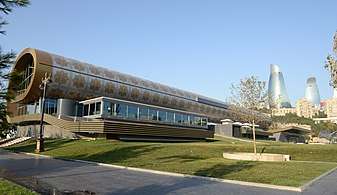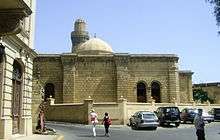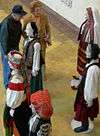Azerbaijan Carpet Museum
Azerbaijan National Carpet Museum (Azerbaijani: Azərbaycan Milli Xalça Muzeyi, formerly called the Azerbaijan Carpet Museum) is a museum located in Baku that displays Azerbaijani carpets and rugs of various weaving techniques and materials from various periods.[1] It has the largest collection of Azerbaijani carpets in the world.[2] It moved to a new building on the Baku's seafront park during 2014 from its former location on Neftchiler Avenue.[3]
 | |

| |
| Established | 1967 |
|---|---|
| Location | Mikayil Huseynov Street 28, Baku, Azerbaijan |
| Coordinates | 40°21′35″N 49°50′07″E |
| Type | Museum |
| Director | Shirin Malikova |
| Public transit access | M 1 Icheri Sheher metro station |
| Website | www.azcarpetmuseum.az |
Azerbaijan National Carpet Museum was established in accordance with the decree No. 130 of the Council of Ministers of the Azerbaijan SSR dated March 13, 1967. From 1967 to 1993, the museum was called the Azerbaijan State Museum of Carpet and Folk Applied Arts, from 1993 to 2014 – State Museum of Carpet and Applied Arts named after Latif Karimov, from 2014 to 2019 – Azerbaijan Carpet Museum, and from 2019 to the present – Azerbaijan National Carpet Museum.
History

The museum was established in 1967 and was initially located in the Juma Mosque in Icheri Sheher. The mosque was built in the 15th century and renovated in the 19th century. Its first exhibition was held in 1972. In 1992, after the collapse of USSR, the museum was moved to the second floor of what is now the Baku Museum Center,[4] a building that had originally been the Lenin museum.[5] The collection was named in honour of the carpet designer Latif Karimov.
Plans to move the collection to a new purpose-built venue have been in the works since 2010 when Azerbaijani carpets were proclaimed "a Masterpiece of Intangible Heritage" by UNESCO.[6] The new building was due to open in late 2012[6] and was visited by President Ilham Aliyev in September 2013.[7] The museum opened on 26 August 2014. In April 2014 the museum was renamed the Azerbaijan Carpet Museum, dropping its much longer official title.[8]
Azerbaijan National Carpet Museum was established in accordance with the decree No. 130 of the Council of Ministers of the Azerbaijan SSR dated March 13, 1967. From 1967 to 1993, the museum was called the Azerbaijan State Museum of Carpet and Folk Applied Arts, from 1993 to 2014 – State Museum of Carpet and Applied Arts named after Latif Karimov, from 2014 to 2019 – Azerbaijan Carpet Museum, and from 2019 to the present – Azerbaijan National Carpet Museum.
At the time of establishing, it was the only museum that was dedicated to the art of carpet weaving. The main purpose of the museum's creation was to store, research, and demonstrate unique examples of the carpet weaving art, which are Azerbaijan's national heritage. The initiator of the museum was Latif Karimov, the outstanding scientist and carpet weaver, founder of the science of Azerbaijan Carpet Art, artist and teacher, author of the fundamental work Azerbaijani Carpet.
The first permanent exhibition was presented on April 26, 1972, in the building of the Juma Mosque, an architectural monument of the 19th century, located in Icherisheher (Old City). The national leader of Azerbaijan Heydar Aliyev, who provided great support to the museum from the first days of its establishment, took part at the opening ceremony. In 1970–1980s, with the constant help of the country's leadership in the person of Heydar Aliyev, Museum had regular opportunities to purchase crafts and thereby replenish its collections. In those years, masterpieces of Azerbaijani Carpet Weaving Art were purchased for the museum.
In 1992, the State Museum of Carpet and Applied Arts was moved to the Museum Center (former Lenin Museum), located at the Neftchilar Avenue. In 1991, after the collapse of the Soviet Union, according to the presidential decree, the building was given to the Ministry of Culture of the Republic of Azerbaijan and renamed to Museum Center. The museum exhibition, representing the carpet samples from different regions of Azerbaijan, as well as works of other kinds of applied arts, was located in thirteen spacious rooms on the second floor.
In 2007, the President of the Republic of Azerbaijan Ilham Aliyev signed a decree for the creation of a new building for the museum in the territory of Seaside National Park within the framework of a joint project of the Ministry of Culture and Tourism of the Republic of Azerbaijan, the Heydar Aliyev Foundation, and UNESCO. In 2014, under the direction of Austrian architect Franz Janz, the museum building, which meets all modern requirements, was completed. Over the years, the museum is continuously developed and has become one of the main storage of samples of the Azerbaijan national culture.
Throughout its fifty years, the museum was led by several directors. From 1967 to 1982, it was led by Aziz Aliyev, Honored Art Worker; from 1982 to January 5, 2016 – by Professor Roya Tagiyeva, Honored Cultural Worker, Doctor in Arts. Since March 2, 2016, the museum has been headed by Dr. Shirin Melikova, Honored Cultural Worker.
The museum has become a research, training, cultural and educational center where many events, such as exhibitions, international symposiums, and conferences, are held. During its fifty years of existence, the museum has organized more than thirty exhibitions in different countries throughout the world. In 1983, on the initiative of Heydar Aliyev and the organizational support of UNESCO, the international symposium Art of Oriental Carpets was held in the Azerbaijan Carpet Museum. Later, international symposiums such as Azerbaijan Carpet Weaving Art (1988), and Azerbaijan Carpet and Applied Arts (2003) were held within the participation of the Azerbaijan Carpet Museum. Additionally, in 2007, a symposium dedicated to Latif Karimov's centenary was held at UNESCO headquarters in Paris.
The museum cooperates closely with influential international organizations, such as the European Textile Network (ETN), the European Museum Forum (EMF), the International Council of Museums (ICOM), UNESCO, and the Council for Humanitarian Cooperation of the Member States of the CIS (IFESCO).
In 2004, a law On the Preservation and Development of Azerbaijani Carpet was prepared and adopted within the museum's participation. This law was aimed to implement the registration of Azerbaijani carpets, protect and support their development, and coordinate scientific and methodical training.
In 2010, the Traditional Azerbaijan Carpet Weaving Art was included within the UNESCO Representative List of the Intangible Cultural Heritage of Humanity on the initiative of Mehriban Aliyeva, First Vice-President of Azerbaijan, President of Heydar Aliyev Foundation, member of Milli Majlis (National Parliament of the Republic of Azerbaijan), and Goodwill Ambassador of UNESCO and ISESCO.
Azerbaijan Carpet Museum in accordance with the decree of the Cabinet of Ministers of the Republic of Azerbaijan dated July 15, 2019, received the National status for its significant contribution in popularization and promotion of the Azerbaijani Carpet Weaving Art.
Today, Azerbaijan Carpet Museum, which is located in one of the country's most modern buildings, not only stores a rich collection of artifacts and carpets (our nation's most valuable heritage), but also operates as the site for the comprehensive research of traditional carpet weaving art and its popularization within the world culture.
Building
The structure of the building is intended to look like a rolled carpet. Designed by Austrian architect Franz Janz, the building took over six years to construct. The previous structure, a building of historical significance, was destroyed to make way for the new building.[9]
Collection
The collection of the museum includes over 10,000 items of ceramics, metal works of the 14th century, jewellery from the Bronze Age, carpets and carpet items from the 17th-20th centuries, national garments and embroidery, and applied art works of the Modern Age.[10] The museum organizes public lectures and study courses on carpets and applied arts. It has a book store selling books on Azerbaijani crafts and carpet art.[2] The museum also holds a permanent collection from the Shusha Museum of History, from the city of Shusha, which was looted after occupation by Armenian troops in 1992. Some of the exhibited items of the Shusha museum were saved when the director of the museum moved out 600 carpets before occupation. They are now displayed at the museum in an exhibition titled "Burned Culture".[5]
International exhibitions
The museum does research and public service work. Every year, state and international exhibitions are organized and catalogues on carpets are printed by the museum. The museum has also held exhibitions in more than 30 countries including France, Germany, England, Japan, the Netherlands. In 1998, the museum participated in a UNESCO-organized exhibition in Paris dedicated to Fuzûlî and in 1999 dedicated to the 1,300th anniversary of the Book of Dede Korkut and displayed carpets, folk applied art items, including copper jugs, mugs, buckets and saddle-bags.[5]
Admissions & Ticketing
Working time
Weekdays: Tuesday-Friday – 10 am.- 6 pm.
Weekends: Saturday-Sunday – 10 am.- 8 pm.
Day off is Monday.[11]
Entrance fee
Ticket for adults is 7 AZN, for pupils and students is 3 AZN.
Ticket for children under 6 years is free.[11]
See also
- Azerbaijan State Museum of Art
- Azerbaijan State Museum of History
References
- "History of Azerbaijan Carpet Museum".
- "AZERBAIJAN CARPET MUSEUM". Archived from the original on July 1, 2010. Retrieved August 20, 2010.
- "Azerbaijan Carpet Museum". azcarpetmuseum.az. Retrieved 2017-05-07.
- Museum Center
- "Baku's National Carpet Museum". Archived from the original on 2010-07-11. Retrieved August 20, 2010.
- New museum planned for late 2012
- Aliyev inspects new carpet museum
- Museum renamed
- Doyle, Rachel (October 10, 2014). "Azerbaijan Now Has a Carpet Museum That Looks Like a Carpet". Curbed. Retrieved October 10, 2017.
- "Carpets Made to Last - A Walk Through Baku's National Carpet Museum". Azerbaijan International. Retrieved August 20, 2010.
- "Home page". Official website of Azerbaijan Carpet Museum.
- "Contacts". Official website of Azerbaijan Carpet Museum.
External links
- Official website (in Azerbaijani, English, and Russian)
- Azerbaijan Carpet Museum at Google Cultural Institute
- Azerbaijani Carpets
- Carpet Weaving in Azerbaijan
